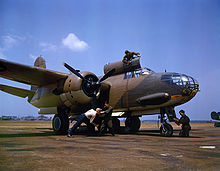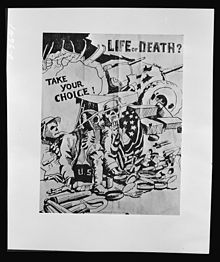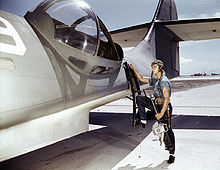| OWI | |
 | |
| Agency overview | |
|---|---|
| Formed | June 13, 1942 |
| Preceding agencies |
|
| Dissolved | September 15, 1945 |
| Superseding agencies | |
| Jurisdiction | United States Government |
| Headquarters | Washington, D.C., United States |
| Parent agency | Office for Emergency Management |
| Child agencies |
|
The United States Office of War Information (OWI) was a United States government agency created during World War II. The OWI operated from June 1942 until September 1945. Through radio broadcasts, newspapers, posters, photographs, films and other forms of media, the OWI was the connection between the battlefront and civilian communities. The office also established several overseas branches, which launched a large-scale information and propaganda campaign abroad. From 1942 to 1945, the OWI reviewed film scripts, flagging material which portrayed the United States in a negative light, including anti-war sentiment.
History
Origins
President Franklin D. Roosevelt promulgated the OWI on June 13, 1942, by Executive Order 9182. [1] The Executive Order consolidated the functions of the Office of Facts and Figures (OFF, OWI's direct predecessor), the Office of Government Reports, and the Division of Information of the Office for Emergency Management. The Foreign Information Service, a division of the Office of the Coordinator of Information, became the core of the Overseas Branch of the OWI. [2]
At the onset of World War II, the American public was in the dark regarding wartime information. One American observer noted: "It all seemed to boil down to three bitter complaints...first, that there was too much information; second, that there wasn't enough of it; and third, that in any event it was confusing and inconsistent". [2] Further, the American public confessed a lack of understanding as to why the world was at war, and held great resentment against other Allied Nations. [3] President Roosevelt established the OWI to both meet the demands for news and less confusion, as well as resolve American apathy towards the war.

The OWI's creation was not without controversy. The American public, and the United States Congress in particular, were wary of propaganda for several reasons. First, the press feared a centralized agency as the sole distributor of wartime information. [4] Second, Congress feared an American propaganda machine that could resemble Joseph Goebbels' operation in Nazi Germany. [5] Third, previous attempts at propaganda under the Committee on Public Information/Creel Committee during WWI were viewed as a failure. [6] And fourth, the American public favored an isolationist or non-interventionist policy and were therefore hesitant to support a pro-war propaganda campaign targeting Americans.
But in the wake of the attack on Pearl Harbor, the need for coordinated and properly disseminated wartime information from the military/administration to the public outweighed the fears associated with American propaganda. President Roosevelt entrusted the OWI to journalist and CBS newsman Elmer Davis, with the mission to take "an active part in winning the war and in laying the foundations for a better postwar world". [7]
President Roosevelt ordered Davis to "formulate and carry out, through the use of press, radio, motion picture, and other facilities, information programs designed to facilitate the development of an informed and intelligent understanding, at home and abroad, of the status and progress of the war effort and of the war policies, activities, and aims of the Government". [8] The OWI's operations were thus divided between the Domestic and Overseas Branches.

Domestic operations
The OWI Domestic Radio Bureau produced series such as This is Our Enemy (spring 1942), which dealt with Germany, Japan, and Italy; Uncle Sam, which dealt with domestic themes; and Hasten the Day (August 1943), which focused on the Home Front, the NBC Blue Network's Chaplain Jim. The radio producer Norman Corwin produced several series for the OWI, including An American in England, An American in Russia, and Passport for Adams, which starred Robert Young, Ray Collins, Paul Stewart and Harry Davenport. [9]

In 1942 the OWI established the Voice of America (VOA), which remains in service as the official government international broadcasting service of the United States. The VOA initially borrowed transmitters from the commercial networks. The programs OWI produced included those provided by the Labor Short Wave Bureau, whose material came from the American Federation of Labor and the Congress of Industrial Organizations.

In conjunction with the War Relocation Authority, the OWI produced a series of documentary films related to the internment of Japanese Americans. Japanese Relocation and several other films were designed by Milton S. Eisenhower to educate the general public on the internment, to counter the tide of anti-Japanese sentiment in the country, and to encourage Japanese-American internees to resettle outside camp or to enter military service. The OWI also worked with camp newspapers to disseminate information to internees. [10]
During 1942 and 1943 the OWI boasted two photographic units whose photographers documented the country's mobilization during the early years of the war, concentrating on such topics as aircraft factories and women in the workforce. In addition, the OWI produced a series of 267 newsreels in 16 mm film, The United Newsreel which were shown overseas and to US audiences. These newsreels incorporated U.S. military footage. For examples see this Google list.
Bureau of Motion Pictures
The OWI Bureau of Motion Pictures (BMP) headed by Lowell Mellet worked with the Hollywood movie studios to produce films that advanced American war aims. According to Elmer Davis, "The easiest way to inject a propaganda idea into most people’s minds is to let it go through the medium of an entertainment picture when they do not realize that they are being propagandized." [11] Successful films depicted the Allied armed forces as valiant "Freedom fighters", and advocated for civilian participation, such as conserving fuel or donating food to troops. [12]
The BMP's first act was the creation and distribution of a "Manual for the Motion-Picture Industry" this provided guidance on how to promote Anti-Fascist democratic principles. [13] The influence of this was limited and instead they began to request scripts to review and approve. By 1943 every major Hollywood studio (except Paramount Pictures) allowed the OWI to examine their film scripts. [14] OWI evaluated whether each film would promote the honor of the Allies' mission. [15] Unlike the office of the Production Code whose approval was required for major studio releases, the OWI's role was advisory, and they lacked the power to prevent films from release. However, the Office of Censorship could deny a film an export license. [16]
The BMP created documentaries and training films for soldiers. The Why We Fight series directed by Frank Capra was shown to American soldiers to explain and justify America's involvement in the war. [17] By July 1942 OWI administrators realized that the best way to reach American audiences was to present war films in conjunction with feature films and some documentaries such as Why We Fight received theatrical release. [17]
Foreign operations
The Overseas Branch enjoyed greater success and less controversy than the Domestic Branch. [18] Abroad, the OWI operated a Psychological Warfare Branch (PWB), which used propaganda to terrorize enemy forces in combat zones, in addition to informing civilian populations in Allied camps. [19] Leaflet warfare gained popularity during World War II and was utilized in regions such as Northern Africa, Italy, Germany, the Philippines, and Japan. For example, in Japan, the OWI printed and dropped over 180 million leaflets, with about 98 million being dropped in the summer months of 1945. [20] Leaflets dropped in Tunisia read: “You Are Surrounded” and “Drowning Is a Nasty Death”. [21] Millions of leaflets dropped in Sicily read: “The time has come for you to decide whether Italians shall die for Mussolini and Hitler – or live for Italy and civilization”. [22]
OWI also used newspapers and publicized magazines to further American war aims. Magazines distributed to foreign audiences, such as Victory, intended to convey to foreign Allied civilians that American civilians were contributing to the war. [23] Victory showcased America's manufacturing power, and sought to foster an appreciation for the American lifestyle. [24]
Aside from the aforementioned publication and production styles of propaganda, the OWI also utilized unconventional propaganda vehicles known as "specialty items." Specific examples of these items include packets of seeds, matchbooks, soap paper, and sewing kits. The packets of seeds had an American flag and a message printed on the outside that identified the donor. Each matchbook was inscribed with the “Four Freedoms” on the inside cover. Soap paper was etched with the message: "From your friends the United Nations. Dip in water – use like soap. WASH OFF THE NAZI DIRT." Sewing kit pincushions were shaped like a human rear end. On the reverse side lay a caricatured face of either Adolf Hitler or Japanese General Hideki Tojo. [25]

The details of OWI's involvement can be divided into operations in the European and Pacific Theaters.
European Theater
One of the most astounding of all OWI operations occurred in Luxembourg. Known as Operation Annie, the United States 12th Army Group ran a secret radio station from 2:00–6:30 am every morning from a house in Luxembourg pretending to be loyal Rhinelanders under Nazi occupation. They spoke of Nazi commanders hiding their desperate position from the German public, which caused dissent among Nazi supporters. Further, they led Nazi forces into an Allied trap, and then staged an Allied attack on the Annie Radio office to maintain their cover. [26] [27]
On the Eastern front, the OWI struggled not to offend Polish and Soviet Allies. [28] As the Soviets advanced from the East towards Germany, they swept through Poland without hesitation. However, Poles considered much of the land of the Eastern front as their own. The OWI struggled to present the news (including the pronunciation of town names or and discussion of county or national boundaries) without offending either party. Further, Poles and Soviets criticized the OWI for promoting the idealization of war, when their physical and human losses so heavily outweighed that of America's. [29]
Pacific Theater
The OWI was one of the most prolific sources of propaganda in “Free China.” They operated a sophisticated propaganda machine that sought to demoralize the Japanese army and create a portrait of US war aims that would appeal to the Chinese audience. OWI employed many Chinese, second-generation Japanese ( Nisei), Japanese POWs, Korean exiles, etc. to help gather and translate information, as well as transmit programs in multiple languages across the Pacific. OWI also created communication channels (logistical support) for intelligence and coded information. [30]
However, the OWI encountered public relations difficulties in China and India. In China, the OWI unsuccessfully attempted to stay removed from the Nationalist versus Communist conflict. However, the Roosevelt administration and OWI officials took issue with many aspects of Chiang Kai-shek’s rule, and conversely, Chiang placed spies in the OWI. [31] Also, the OWI struggled to paint a post-war image of China without offending Nationalist or Communist leaders. In India, the Americans and British agreed to win the war first, then deal with (de)colonization. [32] The OWI feared that broadcasts advocating liberty from oppression would incite India rebellions and jeopardize cooperation with the British. But this approach angered Indians as well as the African-American lobby at home who recognized the hypocrisy in American policy. [32]
Controversies at home
From 1942 to 1945, the OWI's Bureau of Motion Pictures reviewed 1,652 film scripts and revised or discarded any that portrayed the United States in a negative light, including material that made Americans seem "oblivious to the war or anti-war." Elmer Davis, the head of the OWI, said that "The easiest way to inject a propaganda idea into most people's minds is to let it go through the medium of an entertainment picture when they do not realize they're being propagandized". [33]
The OWI suffered from conflicting aims and poor management. For instance, Elmer Davis, who wanted to “see that the American people are truthfully informed,” clashed with the military that routinely withheld information for “public safety”. [34] Further, OWI employees grew ever more dissatisfied with “what they regarded as a turn away from the fundamental, complex issues of the war in favor of manipulation and stylized exhortation”. [35] On April 14, 1943, several OWI writers resigned from office and released a scathing statement to the press explaining how they no longer felt they could give an objective picture of the war because “high-pressure promoters who prefer slick salesmanship to honest information” dictated OWI decision-making. [36] President Roosevelt's “wait-and-see” attitude and wavering public support for OWI damaged public opinion of the agency. [37]

Congressional opposition to the domestic operations of the OWI resulted in increasingly curtailed funds. [38] Congress accused the OWI as President Roosevelt's campaign agency, and pounced on any miscommunications and scandals as reason for disbandment. [39] In 1943, the OWI's appropriations were cut out of the following year's budget and only restored with strict restrictions on OWI's domestic capabilities. Many overseas branch offices were closed, as well as the Motion Picture Bureau. By 1944 the OWI operated mostly in the foreign field, contributing to undermining enemy morale. The agency was abolished in 1945, and many of its foreign functions were transferred to the Department of State.
Some of the writers, producers, and actors of OWI programs admired the Soviet Union and were either loosely affiliated with or were members of the Communist Party USA. [40] The director of Pacific operations for the OWI, Owen Lattimore, who later accompanied U.S. Vice-President Henry Wallace on a mission to China and Mongolia in 1944, was later alleged to be a Soviet agent on the basis of testimony by a defector from the Soviet GRU, General Alexander Barmine. [41] [42] [43]
In his final report, Elmer Davis noted that he had fired 35 employees, because of past Communist associations, though the FBI files showed no formal allegiance to the CPUSA. After the war, as a broadcast journalist, Davis staunchly defended Owen Lattimore and others from what he considered outrageous and false accusations of disloyalty from Senator Joseph R. McCarthy, Whittaker Chambers and others. Flora Wovschin, who worked for the OWI from September 1943 to February 1945, was later revealed in the Venona project intercepts to have been a Soviet spy. [44]
Dissolution and legacy
The OWI was terminated, effective September 15, 1945, by Executive Order 9608 on August 31, 1945. [45] President Truman cited the OWI for "outstanding contribution to victory", and saw no reason to continue funding the agency post-war. [46] The international offices of the OWI were transferred to the State Department, and the United States Information Service and the Office of Strategic Services/ Central Intelligence Agency assumed many of the information gathering, analyzing, and disseminating responsibilities. [47]
Despite its troubled existence, the OWI is widely considered to be influential in the Allied victory and mobilizing American support for the war domestically.

People
Among the many people who worked for the OWI were Eitaro Ishigaki, Ayako Tanaka Ishigaki, Jay Bennett, Humphrey Cobb, Alan Cranston, Elmer Davis, Gardner Cowles Jr., Martin Ebon, Milton S. Eisenhower, Ernestine Evans, John Fairbank, Lee Falk, Howard Fast, Ralph J. Gleason, Alexander Hammid, Leo Hershfield, Jane Jacobs, Lewis Wade Jones, David Karr, Philip Keeney, Christina Krotkova, Owen Lattimore, Murray Leinster, Paul Linebarger, Irving Lerner, Edward P. Lilly (historian), Alan Lomax, Archibald MacLeish, Reuben H. Markham, Lowell Mellett, Edgar Ansel Mowrer, Charles Olson, Gordon Parks, James Reston, Peter C. Rhodes, Robert Riskin, Arthur Rothstein, Waldo Salt, Arthur Schlesinger, Jr., Wilbur Schramm, Robert Sherwood, Dody Weston Thompson (researcher-writer), William Stephenson, George E. Taylor, Chester S. Williams, Flora Wovschin, and Karl Yoneda.
Filmography
- This is Our Enemy
- Hasten the Day
- An American in England
- An American in Russia
- Japanese Relocation (1942)
- Chaplain Jim
- Passport for Adams
See also
Notes
- ^ Peters, Gerhard; Woolley, John T. "Franklin D. Roosevelt: "Executive Order 9182 Establishing the Office of War Information.," June 13, 1942". The American Presidency Project. University of California, Santa Barbara. Archived from the original on 2018-09-12.
- ^ a b Weinberg, p. 77
- ^ Weinberg, p. 78
- ^ Winkler, p. 23
- ^ Winkler, p. 4
- ^ Winkler, p. 3
- ^ Winkler, p. 1
- ^ Winkler, p. 34
- ^ Passport for Adams. The Billboard, August 28, 1943, p. 12. 1943-08-28. Retrieved 2014-11-15.
- ^ Mizuno, Takeya. "Changing the Image of Japanese Americans". Densho Encyclopedia. Retrieved 14 November 2014.
- ^ Koppes and Black, p. 64.
- ^ Winkler, p. 57
- ^ Koppes, Clayton R.; Black, Gregory D. (1977). "What to Show the World: The Office of War Information and Hollywood, 1942-1945". The Journal of American History. 64 (1): 87–105. doi: 10.2307/1888275. ISSN 0021-8723. JSTOR 1888275.
- ^ Koppes and Black, p. 112
- ^ Worland, p. 50.
- ^ Billheimer, John W. (2019). "Lifeboat (1944)". Hitchcock and the Censors. The University Press of Kentucky. ISBN 9780813177434.
- ^ a b Seagren, Chad W.; Henderson, David R. (2018). "Why We Fight: A Study of U.S. Government War-Making Propaganda". The Independent Review. 23 (1): 69–90. ISSN 1086-1653. JSTOR 26591800.
- ^ Winkler, p. 76
- ^ Winkler, p. 142
- ^ Winkler, p. 79
- ^ Winkler, p. 117
- ^ Winkler, p. 118
- ^ Winkler, p. 67
- ^ Winkler, pp. 155–156
- ^ Winkler, p. 80
- ^ Winkler, p. 128
- ^ "Radio: Operation Annie". Time. 1946-02-25. ISSN 0040-781X. Retrieved 2021-12-02.
- ^ Hammersmith, p. 68
- ^ Hammersmith, p. 75
- ^ Johnson, p. 307
- ^ Johnson, p. 338
- ^ a b Winkler, p. 83
- ^ "How Hollywood became the unofficial propaganda arm of the U.S. military". CBC News. 2020-05-11. Retrieved 2022-06-06.
- ^ Winkler, p. 47
- ^ Winkler, p. 64
- ^ Weinberg, p. 87
- ^ Weinberg, p. 80
- ^ Winkler, p. 68
- ^ Winkler, p. 66
- ^ Haynes and Klehr, pp. 197–198
- ^ FBI Report, "Owen Lattimore, Internal Security – R, Espionage – R," September 8, 1949 ( FBI File: Owen Lattimore, Part 1A), p. 2 (PDF p. 7): Six years prior to the Barmine revelations in his 1948 interview, the FBI had already compiled a thick security dossier on Lattimore at the onset of World War II, recommending that he be put under "Custodial Detention in case of National Emergency."
- ^ Absent-Minded Professor?[ dead link], Time Magazine, Mar. 10, 1952
- ^ Testimony of Alexander Barmine, July 31, 1951, U. S. Congress, Senate Committee on the Judiciary, Internal Security Subcommittee, Institute of Pacific Relations, Hearings, 82nd Congress, First Session (Washington: Government Printing Office, 1951), Part 1, pp. 199–200
- ^ Haynes and Klehr, pp. 198–201
- ^ "Executive Order 9608 – Providing for the Termination of the Office of War Information, and for the Disposition of Its Functions and of Certain Functions of the Office of Inter-american Affairs | The American Presidency Project". www.presidency.ucsb.edu. Retrieved 2020-12-10.
- ^ Winkler, p. 149
- ^ Johnson, p. 341
References
- Allan Winkler, The Politics of Propaganda: The Office of War Information, 1942–1945 (New Haven: Yale University Press, 1978).
- Farm Security Administration/Office of War Information Black-and-White Negatives." Library of Congress. https://www.loc.gov/pictures/collection/fsa/
- Farm Security Administration/Office of War Information Color Photographs." Library of Congress. https://www.loc.gov/pictures/collection/fsac/
- Howard Blue, Words at War: World War II Radio Drama and the Postwar Broadcast Industry Blacklist (Lanham, Maryland: Scarecrow Press, 2002).
- Jack L. Hammersmith, "The U.S. Office of War Information (OWI) and the Polish Question, 1943–1945" (The Polish Review 19, no. 1 (1974)). JSTOR 25777179
- Koppes, Clayton R. and Gregory D. Black. Hollywood Goes to War: How Politics, Profits and Propaganda Shaped World War II Movies (Berkeley: University of California Press, 1990). ISBN 978-0520071612.
- Matthew D. Johnson, "Propaganda and Sovereignty in Wartime China: Morale Operations and Psychological Warfare under the Office of War Information" (Modern Asian Studies 45, no. 2 (2011)). http://journals.cambridge.org/abstract_S0026749X11000023
- Sydney Weinberg, "What to Tell America: The Writers' Quarrel in the Office of War Information" (The Journal of American History 55, no. 1 (1968)). JSTOR 1894252
Archives
- "Records of the Office of War Information (OWI) in the National Archives". 15 August 2016.
- Finding aid to Armitage Watkins papers on the Office of War Information at Columbia University. Rare Book & Manuscript Library.
External links
- OWI images at the Museum of the City of New York
- OWI recordings at the Library of Congress
- Images from the Farm Security Administration – Office of War Information Collection (Library of Congress)
- World War II OWI posters
- World War Poster Collection hosted by the University of North Texas Libraries' Digital Collections
- The Papers of Edward P. Lilly, special assistant to the director of OWI 1944–1945, Dwight D. Eisenhower Presidential Library
- Papers of Paul Sturman, Foreign Language Division of OWI, Dwight D. Eisenhower Presidential Library
- Defunct agencies of the United States government
- United States government propaganda organizations
- Politics of World War II
- Agencies of the United States government during World War II
- Government agencies established in 1942
- American propaganda during World War II
- 1942 establishments in the United States
- 1945 disestablishments in the United States
- Government agencies disestablished in 1945